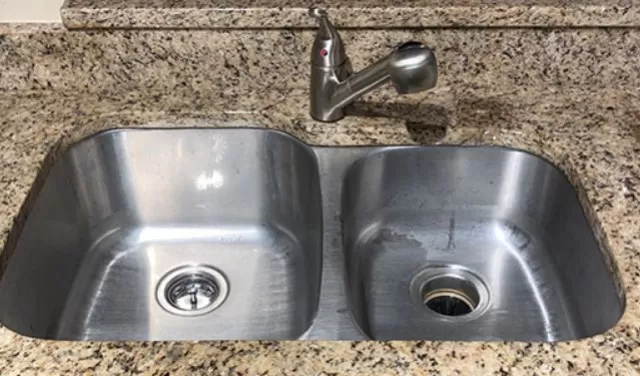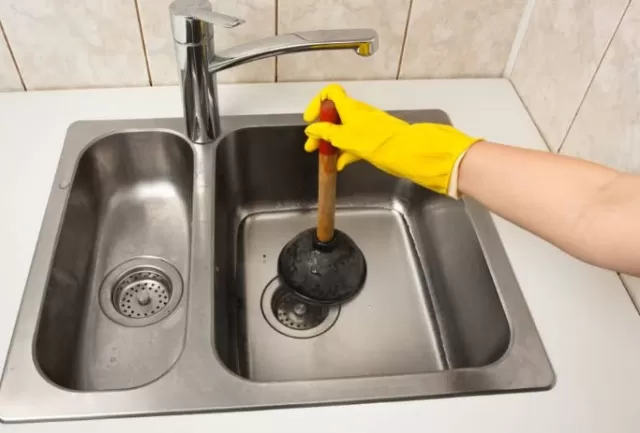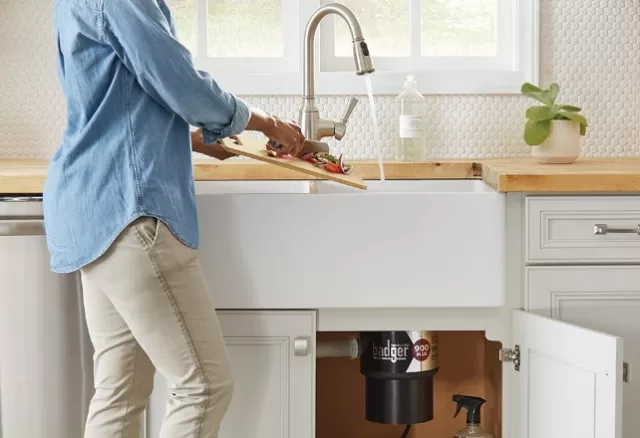How to Unclog a Double Kitchen Sink: A Step-by-Step Guide
Dealing with a clogged double kitchen sink with a garbage disposal can be a little more complicated than a regular clogged sink. Since one side has a garbage disposal and the other doesn’t, both sides share the same P-trap assembly below.
However, with a few simple steps, it’s easy to identify the location of the clog and fix it. In this step-by-step guide, we’ll walk you through the process of unclogging your double kitchen sink with a garbage disposal, so you can get back to using your sink without any issues.
How to Unclog a Double Kitchen Sink: Fixing a Clog on Either Side

When the water on the disposal side of the sink is slow or not moving, the first step is to check if the garbage disposal is working.
It may need to be reset or have its power turned back on. If the disposal is functional but jammed, the obstruction needs to be forced through or pulled out.
On the other hand, if the water on the non-disposal side is blocked or moving slowly, the short tailpiece that leads to the trap is typically clogged.
Using a cup-style drain/sink plunger, the tailpiece can be unclogged.
How to Unclog a Double Kitchen Sink with Garbage Disposal: When Both Sides Are Clogged

In case both sides of a double kitchen sink are clogged, one side’s drain might be draining slowly or not at all, while the other side fills up.
Eventually, both sides will be clogged. Typically, the reason behind this problem is a blockage in the P-trap assembly below the sink or in the drain pipes beyond the P-trap.
The P-trap can be taken out, cleaned, and reinstalled. Moreover, you can use a drain snake, which can reach up to 25 feet down the line, to clear out any blockages in the drain pipes beyond the P-trap.
Safety Considerations When Unclogging a Double Kitchen Sink with a Garbage Disposal

When working with garbage disposals, it is essential to take safety precautions to avoid electrical shock or injuries from the impellers or other moving parts.
The first step in ensuring your safety is to unplug the garbage disposal from the wall outlet located under the kitchen sink.
However, not all garbage disposals have cords, and some are hard-wired into the electrical system. In such cases, you must turn off the circuit breaker that controls the outlet, which can be found on the electric service panel.
It’s also important never to put your fingers into the hopper chamber, as the impellers can be sharp enough to cause lacerations even when they are not moving.
Always use a tool, such as a pair of tongs, to retrieve objects that have fallen into the disposal chamber. By taking these precautions, you can safely and effectively address any issues that arise with your garbage disposal.
How to Fix a Clog On the Disposal Side: A Step-by-Step Guide

When faced with a clogged sink on the disposal side, there are a few steps to take before calling a plumber.
First, check the power source by looking for a tripped circuit breaker or a blown fuse on the electric service panel. Next, unplug the disposal from the kitchen base cabinet and clear small obstructions with the disposal accessory wrench or a hex-style Allen wrench.
If there are larger obstructions, use kitchen tongs, handles of wooden spoons, or chopsticks to remove them.
To further clear the clog, block the non-disposal side of the sink with a disposal stopper and plunge the disposal side with a plunger. An assistant can help hold the stopper in place while you use both hands to plunge the other side of the sink.
These steps can help clear most clogs on the disposal side of the sink and avoid the need for a professional plumber.
Fixing a Clog on the Non-Disposal Side of a Double Kitchen Sink
Block the Disposal Side Block the drain on the disposal side with the disposal stopper.
If the stopper is missing, you can purchase an inexpensive replacement or use a wet folded-up hand towel as a substitute.
Plunge the Non-Disposal Side While holding the stopper on the disposal side of the sink in place, use the plunger with the other hand to plunge the non-disposal side.
When to Call a Professional: Knowing When to Get Help with Plumbing Issues
When to Call a Professional for a Clogged Kitchen Sink.
If you have tried all the DIY methods to unclog your kitchen sink, but the problem persists, it’s best to call a licensed plumber.
In such cases, the garbage disposal unit may be faulty and require replacement. A plumber can also assist in snaking the drain from the house to the municipal sewer main, using specialized equipment like sewer video scopes and locator units to identify and remove blockages.
It is recommended to seek professional help to avoid further damage to the plumbing system.
*The information is for reference only.